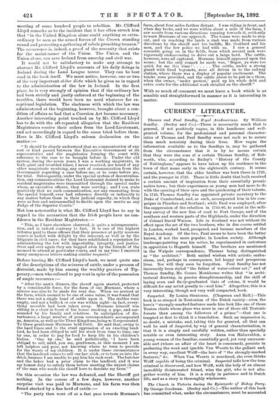CURRENT LITERATURE.
Thomas and Paul Sandby, Royal Academicians. By William Sandby. (Seeley and Co.)—There is necessarily much that is general, if not positively vague, in this handsome and well- printed volume, for the professional and personal character- istics of Thomas and Paul Sandby were not such as to secure them much notoriety during their lives. How vague the information available as to the Sandbys is, may be gathered from the circumstance that it is by no means certain that they were the sons of a certain Thomas Sandby, of Bab- worth, who, according to Bailey's " History of the County of Nottingham," appears to have taken up his residence in the town of that name early in the eighteenth century. It seems certain, however, that the elder brother was born there in 1721, and the younger in 1725. There is little doubt that both received a certain amount of inspiration from their essentially prosaic native town; but their experiences as young men had more to do with the opening of their eyes and the quickening of their talents. In 1743, Thomas Sandby was appointed private secretary to the Duke of Cumberland, and, as such, accompanied him in his cam- paigns in Flanders and Scotland ; while Paul was employed, after the suppression of the rebellion in 1745-46, to assist in the mili- tary survey of the new line of road to Fort George, and of the southern and western parts of the Highlands, under the direction of Colonel David Watson. Life in Scotland was not without its effect upon the art of the two brothers, who in due course settled in London, worked hard, prospered, and became members of the Royal Academy. Of the two, Paul seems to have been the better known, if not the more popular, in London society. Although landscape-painting was his metier, he experimented in caricature in opposition to Hogarth himself. The brothers are mentioned in the Walpole correspondence, Thomas being distinguished as " the architect!' Both united wisdom with artistic enthu- siasm, and, perhaps in consequence, led happy and prosperous lives. Nor will they soon be forgotten. Paul Sandby has not incorrectly been styled " the father of water-colour art ;" and of Thomas Sandby, Mr. Cosmo Monkhouse writes that "in archi- tectural drawing, in precise draughtsmanship, and the skill of laying even and finely-graduated tints of colour, it would be difficult for any artist greatly to excel him." Altogether, this is a very interesting, though not very well compacted, book.


































 Previous page
Previous page